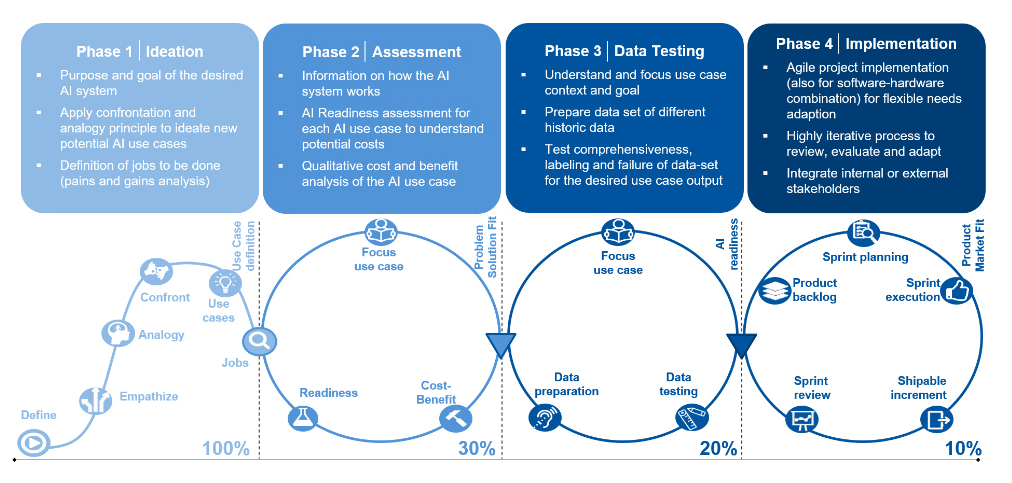Newsletter 02/2021
KEX AG and Fraunhofer IIS/EAS have jointly developed the so-called "AI Navigator". With it, they want to give companies a tool with which they can find their individually optimal way to use AI technologies successfully and profitably. Antonela Sisejkovic, Senior Technology Scout at KEX AG, and Anne Loos, Head of Business Development at Fraunhofer IIS/EAS, give us an insight into the idea behind the tool.
Artificial intelligence (AI) is on everyone's lips. Countless companies are already trying their hand at it. How can these companies benefit from the AI Navigator?
Anne Loos: Artificial intelligence has become a rather hype word in the last couple of years. It has become almost a common understanding that you can and should solve every problem – in particular highly complex ones – with artificial intelligence, which has often been the reason why many AI applications failed.
Antonela Šišejković: That is where the AI navigator comes into play: identifying and then implementing the right AI use cases is a continuous learning process, but also a crucial part towards successful use of artificial intelligence. A lot of use cases turn out to be not as easy as they seemed in the beginning. That is why we have come up with our 4-step approach to make sure only the truly promising and value-adding use cases are pursued.
Can you briefly explain the principle of your approach?
Antonela Šišejković: The AI navigator consists of 4 stages: Ideation, Assessment, Data Testing, Implementation. First, the ideation step is based on the principle: "Start with more, stay with less". It is an important creative process in which new use case ideas are found based on the patterns from previously successfully implemented AI use cases by KEX AG. The identified ideas are then methodically tested to define the problem-solution fit.
Second, the assessment step in the process helps to identify if the company is ready to implement the potential use cases, from the perspective of readiness and competencies. The company is assessed in terms of processes, data base, mindset as well as IT infrastructure. Company´s categorization into the AI maturity levels provides guidelines on how to proceed to enable a successful implementation of AI use cases. The understanding of the range of the maturity levels is comparable to the autonomous driving levels, from simple support and simplification systems and automation to full autonomy.
Anne Loos: The third step, data testing, ensures there is an adequate amount of required structured data sets in the right quality to yield the necessary results. Data testing provides initial insights concerning the feasibility of the use case prior to a full implementation. Finally, in the last step, the implementation, the focus is on agile development methods to ensure the built solution is user driven and that it matches the customer requirements.
Are there any limitations to your approach in terms of company size or industry that need to be considered?
Antonela Šišejković: There are no limitations in the use of the AI navigator regarding the size and the industry of a company. Choosing the right use case before investing significant amount of money and resources is a key requirement for both, small and big companies.
Can the companies use the principle independently or does it require professional support?
Anne Loos: We have been accompanying our clients for many years during the exploration and implementation of AI solutions. In order to be able to use the tool independently, it is advisable to undergo at least basic training in the field of AI to understand the technological fundamentals and stay up to date e.g., of current best practices. With regular trainings (basic, as well as advanced), we provide the necessary key knowledge headed by KEX AG. Besides this, we offer train-the-trainer programs to enable interested companies to use our AI Navigator.
What do you recommend to companies that want to use AI in their business?
Antonela Šišejković: It is important to have a clear understanding of the problem that should be solved, when looking for AI use cases. Only then can an approach like technology scouting be utilized to find potential solutions. It can then either be AI or another existing data analytics solution that successfully solves the defined problem.
 Fraunhofer Institute for Integrated Circuits IIS, Division Engineering of Adaptive Systems
Fraunhofer Institute for Integrated Circuits IIS, Division Engineering of Adaptive Systems